The T-Mobile G2 Preview
by Vivek Gowri on October 7, 2010 12:29 PM ESTOh yes, and now we get to the real stuff. Benchmarks! Let’s start with the CPU benchmarks to see how the 800 MHz 2nd gen Snapdragon matches up with the older 1 GHz parts. All of them implement the same Scorpion architecture, except that the MSM7230 is manufactured on a 45nm process as opposed to 65nm for the QSD8x50. Simple colour coding scheme going on in the graphs here: red for the G2, green for the 1st generation Snapdragon phones, blue for anything running TI OMAP 3 underhood, gold for the Hummingbird Galaxy S devices, black for the iPhone 4, and purple for the Marvell PXA930-running BlackBerry Torch.
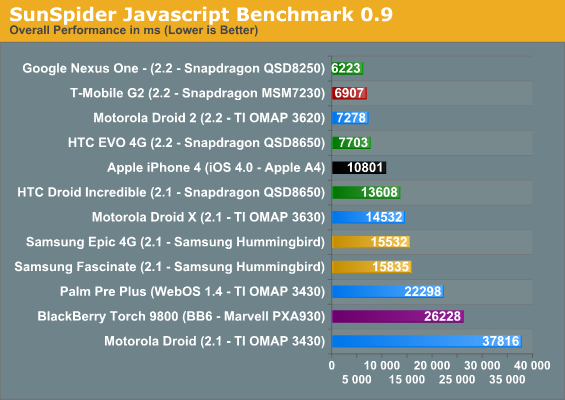
The SunSpider Javascript benchmark is very quick on the G2. While the Froyo Nexus One remains the fastest on most of these benchmarks, the G2 is definitely getting there, probably due to the untouched Android build it’s running. So even with a slower clockspeed, the G2 has a better score on the JS benchmark than the NinjaBlur-equipped Droid 2 and the Sense UI-equipped EVO 4G.

Rightware’s BrowserMark puts the G2 right between the Droid 2, the Fascinate, and the iPhone 4, and about 20% slower than the Nexus One. Given the 20% reduction in clock speed, this is pretty understandable.
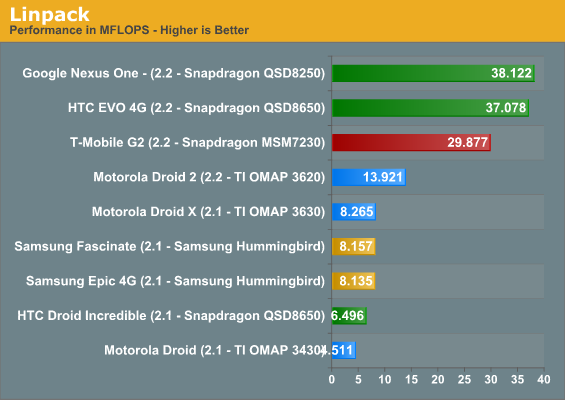
The G2’s Linpack score is about 25% lower than the Nexus One and EVO 4G, but significantly higher than the Droid 2’s score, potentially due to the higher throughput SIMD FP units in Qualcomm's CPU.
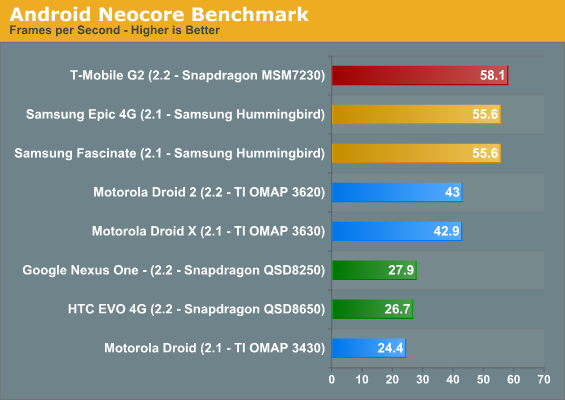
But the really interesting benchmarks are the graphics benchmarks. We’ll start with Neocore, which is Qualcomm’s benchmark to show off the capabilities of the Adreno GPU.
The score is quite good, at more than double the Nexus One’s. The benchmark is capped at roughly 60 fps which is why we see no real difference between the Adreno 205 and the PowerVR SGX 540. For a measurable performance difference we turn to our old favorite: Quake 3.
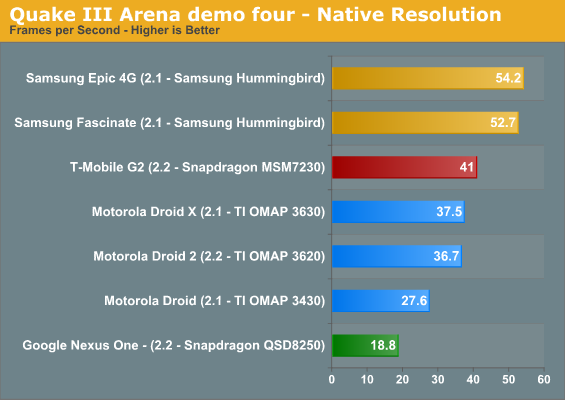
In a neutral gaming benchmark like the Quake III Arena demo, we can really get a feel for how fast Adreno 205 is. And though nothing on the market can touch the SGX 540, the Adreno 205 basically runs rings around the Adreno 200 in the EVO and Nexus One and even outpaces the SGX 530 in the Droid 2 and Droid X. So while the Adreno 205 isn’t world beating, it brings about a huge change by making the the 2nd generation Snapdragon SoC competitive as far as GPU performance goes. Qualcomm no longer comes with a GPU performance tradeoff.
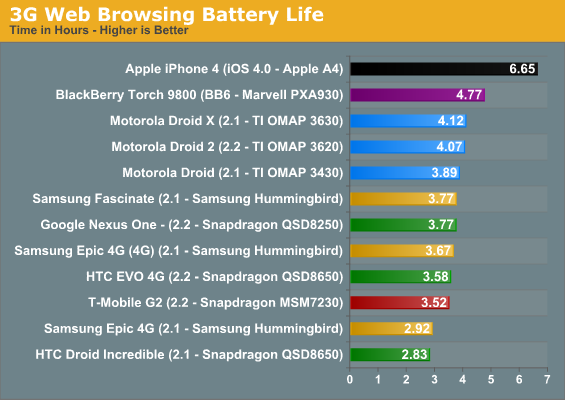
The G2 comes with a pretty small battery, a removable 4.81 Wh (1300 mAh) Li-ion affair that can be easily accessed and replaced. The Nexus One came with a 5.18 Wh battery, the Droid 2 had 5.2 Wh capacity on tap, the Droid X had a 5.6 Wh unit, and the EVO used a 5.5 Wh battery. So naturally, with a lower capacity battery, the G2 comes with less battery runtime too. Thus far we’ve only had the time to run the 3G web browsing battery life test, and the G2 is way down at the very bottom of our charts, matching the Palm Pre Plus in battery life (which has a 1150 mAh battery). It’s not too bad, it’s on par with the Nexus One for minutes-per-Wh efficiency, but 3.5 hours of 3G web browsing is still not very good.
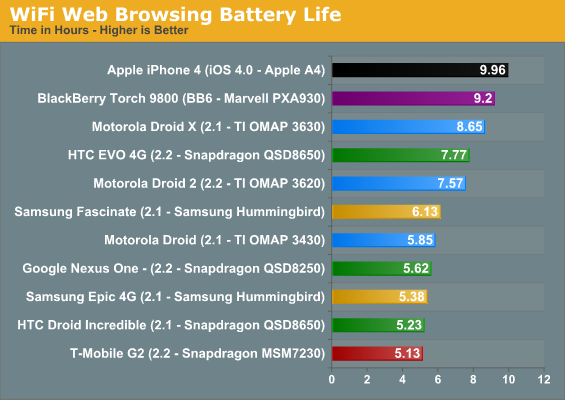
Update: We're adding battery life tests as we go, so here's the WiFi browsing test. Again, it's almost at the bottom, again it's about on par with the Nexus One on an efficiency level. It's a small battery, so when compared to phones that have 10-20% more battery capacity, it does look quite poor. What does seem to be consistent though is that the OMAP 3 phones are more power efficient, even on a per-Wh basis.

But given the 3G speeds the G2 is pulling, maybe we should give it a pass. T-Mobile's HSPA+ network is FAST, even in areas of Seattle that have rather poor signal coverage. On average, I'm pulling around 5.5 Mbps downstream and anywhere between 1 and 1.5 Mbps upstream. Interestingly, this is signifcantly faster than the speeds I saw out of Sprint's WiMAX 4G network on the EVO when I had it in June. While I can't vouch for areas that don't have T-Mobile's HSPA+ network enabled yet, the areas that do should see the G2 fly. It's T-Mobile's first HSPA+ device, so it should be able to utilise the full potential of the faster network.










59 Comments
View All Comments
strikeback03 - Thursday, October 14, 2010 - link
Installing programs to the SD card is a function of both the OS and the app developer, Froyo now allows it but the developer also has to enable it. So right now I would imagine some programs can be moved and some can't.jmunjr - Sunday, October 10, 2010 - link
T-mobile disabled tethering on the G2. I used a G2 last night and this is the first T-Mobile smart phone I've been sold on...until I found out there is no native tethering support. Well there is but T-Mobile disabled it. Funny thing is tethering support exists in their prepaid Tap device... So silly...Jon Niola - Monday, October 11, 2010 - link
I went and sprung for the G2 this weekend. I am a software developer who is getting into the mobile space now and figured it never hurts to have another test environment.So mind you - I already own an HTC Droid Incredible and HTC Evo 4G and I am using them as a comparison.
First off - the thing that Vivek mentioned that I was most nervous about was the hinge mechanism. I have to say after being a bit rough with it (intentionally) it is strong and I have zero concerns about it breaking from regular use. The hinge actually has a horizontal support piece underneath as well that reinforces the two "posts" that connect the top half.
As for battery life it is actually holds charge longer than my Incredible or Evo 4G. While I am not doing a byte-for-byte, use-for-use comparison, I have been impressed at how even idle the battery goes down slower than the other two.
The build quality of this thing is actually impressive. Yes it is heavy - but a good heavy. It feels like a friggin tank in the hand. The brushed aluminum is a winner too. Does not feel cheap or plasticy at all but rather feels like a refined, well-made device.
Still getting use to the vanilla Android vs the Sense-enhnaced that I am used to but from a developer standpoint it is nice to have a clean test bed like that :)
Honestly I feel it was worth every penny.
rester555 - Monday, October 11, 2010 - link
I went to a T-mobile store to see if the OS was stock? It was indeed running Android Froyo 2.2, but it was not stock. It had the tethering options disabled.So is this really a stock version of Froyo?
Jon Niola - Tuesday, October 12, 2010 - link
News going around today that a stealth OTA update is re-enabling native tethering.Why it was disabled is beyond me but looks like it is coming back.
synaesthetic - Thursday, October 14, 2010 - link
It's not stock. It's almost stock; there are some crapware apps that CANNOT be uninstalled without root (which, due to the G2's restore-on-reboot function, does not stick).Tethering is also disabled and removed, as you've noticed, though some folks have (supposedly) received an OTA update re-enabling USB and Wi-Fi tethering as well as adding T-Mobile's Wi-Fi Calling app.
lukeevanssi - Tuesday, October 12, 2010 - link
when I saw this mobile phone than I understand to about this feature and details so I found here..http://burnxtreme.net/
jeans_xp - Wednesday, October 20, 2010 - link
HAHA, first smart phone is iPhone 3GS. I find a good website for smart phone news and latest technology:www.mobilegoing.com
jeans_xp - Sunday, November 7, 2010 - link
No Samsung Galaxy S.www.mobilegoing.com